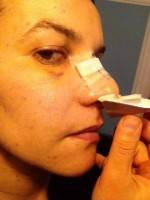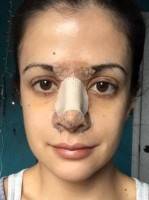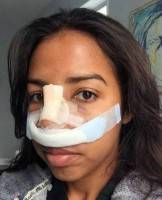Rhinoplasty Swelling Timeline
Rhinoplasty swelling timeline is one of the biggest concerns for patients. Many patients (and some surgeons) that the nose is mostly healed at one month.
However, while the nose may look presentable at 3 weeks, the nose’s shape will continue to change over the first year, with the majority of healing taking placed during that time.
Noses which are projected (stick out further from the face than the original nose) tend to swell less than noses which are deprojected (brought closer to the face) due to the process of the skin accomodating to the new shape of the nose.
An experienced rhinoplasty surgeon’s office will be able to guide you through the early postoperative swelling phase and give you activities you can do and avoid during the early phases of your recovery. (Anil R. Shah, MD, Chicago Facial Plastic Surgeon)
How Long Before Swelling Goes Down After Rhinoplasty
The answer to this depends to some degree on whether you had an open or closed rhinoplasty procedure. With a closed approach (where no incisions are made externally) you will still be swollen at 3 weeks out.
However, you will likely look fairly presentable in the public eye. With an open rhinoplasty approach, you will also look presentable but have slightly more swelling than a closed approach at 3 weeks out.
You will notice a gradual decline in swelling as the weeks go on with a plateau in your healing process around 1 year out. (John M. Hilinski, MD, San Diego Facial Plastic Surgeon)
Rhinoplasty swelling timeline
The swelling after rhinoplasty can take a long timeline to completely go away. There is a three phase healing process from rhinoplasty. The first 2-3 weeks the initial swelling will be getting better. You will begin to see the new shape of the nose. The second phase is 2-3 months during which most of the swelling will go away.
You will start seeing the details in your nose and the true shape will come out. The final phase can take up to a year. You may have swelling at the tip and some numbness in some parts of your nose for a long period of timeline. Three weeks after surgery it is very common to have swelling. Try to be patient and allow time to improve the swelling. You’re about 1-2 months away from really enjoying your new nose! (Adam Rubinstein, MD, Miami Plastic Surgeon)
Rhinoplasty swelling after 3 weeks is expected
It is very normal and expected to have swelling after only 3 weeks following rhinoplasty. It is well understood that swelling can last up to a year so be patient and you should see a slow but steady improvement. (Jason B. Diamond, MD, Beverly Hills Facial Plastic Surgeon)
When I was a resident 25 years ago, I was taught that it takes a year to see the final result from a rhinoplasty. This has to do with, not only remodeling of the tissue, but also resolution of the swelling. I tell my patients that 50% of the swelling is gone in two weeks and 70% in two months. A lot of this also depends on how much work is being done.
If the nasal bones are being repositioned, and there is extensive nasal tip work, including grafting, as well as work on the septum, there will be more swelling than if there is just minor external cosmetic work being done. At three weeks , I wouldn’t be too alarmed if there is still some swelling. (Joseph M. Perlman, MD, Houston Plastic Surgeon)
Swelling after Nose Job (Rhinoplasty)
Rhinoplasty swelling timeline can be vary patient to patient and is related to how complex the rhinoplasty surgery was. At 1 week, it is very common to be very swollen, but over the next 2 weeks people are usually only minimally swollen.
Most of our patients in Naples, Florida return to school or work within 2 weeks with cover up makeup. If you are significantly swollen at 3 weeks, you need to see your plastic surgeon to be evaluated.
It is true that swelling persists for 12 – 15 months after a rhinoplasty, but that is the last 20 % of swelling, where the initial 80% of the swelling should be gone by 1 month. (Kent V. Hasen, MD, Naples Plastic Surgeon)
Rhinoplasty swelling can last up to a year in some patients
Rhinoplasty swelling can last up to a year in some patients especially in the lower third of the nose. If one has a complete rhinoplasty including the upper, middle and lower thirds of the nose, the swelling can take a full year to subside even if the noticeable part to others is gone sooner.
For example, the tip can take up to a year or year and a half to reach its normal supple nature and also for all of the tip definition to occur. Typically, the upper third is back to normal in about two weeks.
Close follow-up with your physician is imperative in case any abnormal swelling occurs it can be treated during the healing process. (Scott Trimas, MD, Jacksonville Facial Plastic Surgeon)
There are many factors that influence the timing for swelling to resolve after a rhinoplasty.
As a general rule most patient are comfortable going out after 2 weeks with casual observers unlikely to recognise that they have had any surgery.
Close friends and family will note swelling in the nose for up to 4-6 weeks but by that stage around 80% of the swelling will have resolved.
The remaining 20% tends to be concentrated in tip of the nose and may take many months and up to a year before it settles.
This can be a difficult time for the patient but patience is key and the results will come with time. It is important to remember that the patient can significantly influence the post operative swelling and following instructions from your surgeon is essential to help minimise your rhinoplasty recovery time. (Guy Watts, MBBS (Hons), FRACS (Plast), Perth Plastic Surgeon)
Rhinoplasties vary greatly depending upon the amount of correction needed to achieve the pre-op goal. Internal grafts, suturing, and/or nasal bone repositioning all contribute to the swelling.
Generally, patients are socially acceptable by two weeks, but healing varies between patients and can take longer. It is easy to become frustrated and upset because it is taking longer than expected.
Nasal swelling can be slow but this does not mean anything is wrong or that your final result will not be good. Stay in contact with your physician especially during the first year and have faith. (John Zavell, MD, FACS, Toledo Plastic Surgeon)
Swelling after rhinoplasty
Swelling after rhinoplasty is normal for up to a year after surgery – that is when you have your “final” result. A significant amount of swelling will dissipate by 3-4 months after surgery.
There are several factors that can increase swelling after rhinoplasty: the extent of the dissection, the use of osteotomies (breaking and resetting the bones), the use of cartilage grafts, and the open technique. Discuss these with your surgeon. (Lara Devgan, MD, MPH, New York Plastic Surgeon)
Swelling takes time to resolve
After rhinoplasty, much of the swelling will decrease about two weeks postoperatively. However, the healing process will continue to occur for many months after surgery. Persistent swelling of the nasal tip can occur in some patients depending on their individual anatomy and thickness of their skin.
Throughout the followup period, your plastic surgeon may recommend steroid injections to the nose or nasal taping to aid in resolution of the swelling and produce the best outcome. (Michael T. Somenek, MD, FACS, Washington DC Facial Plastic Surgeon)
Swelling can unfortunately linger much longer than wanted or expected in rhinoplasty recovery – this is why I always counsel my patients that rhinoplasty is essentially a year-long process to obtain a ‘final’ result. Most of the swelling resolves over the first 3-4 weeks, but can linger longer depending upon your individual characteristics (e.g. if the bones broken, if it is a first or second surgery, and how thick your skin is) Be patient, your result will manifest! (Bryan Correa, MD, Houston Plastic Surgeon)
Swelling after rhinoplasty / nosejob
The degree of swelling depends on the amount of dissection, the amount of reduction or change performed and the type of rhinoplasty performed. Closed rhinoplasty, or those without any external incisions, tend to heal much more quickly.
Typically swelling increases slightly the day after the cast comes off then decreases gradually over the next week. a good rule of thumb is that the nose is 80% healed at 3 months. 90% at 6 months. 99% at 1 year and 100% at 2 years. (Ben Talei, MD, Beverly Hills Facial Plastic Surgeon)
Is my swelling after rhinoplasty normal?
Swelling after rhinoplasty is normal. It can vary from patient to patient, and even from day to day. Some patients may even notice changes throughout the day. Your skin may play a big role in the swelling after rhinoplasty.
Patients who have thicker skin may have more swelling than those with thinner skin. In addition, the greater the dissection during the rhinoplasty recovery, the more swelling there may be after the procedure. It is important to follow all of your doctor’s instructions before and after the surgery. Smoking after surgery may affect healing, and you should limit your alcohol intake as this may increase swelling as well.
Ask your doctor when you can resume full activities. Rhinoplasty overall can take up to a full year to heal, so try to be patient. It is not always easy, but you can always check in with your doctor to make sure your healing is on schedule. (Jennifer Levine, MD, New York Facial Plastic Surgeon)
Some swelling and bruising is expected after the nose surgery and most of it will subside in 8-10 days. However, some swelling may continue or come and go until 1 year and for patients with thicker skin even up to 2 years.
Often this is the degree of swelling that is not discernible to everyone and mostly the patient can see it. Reducing the salt intake may minimize the morning swelling. (Bahman Guyuron, MD, Cleveland Plastic Surgeon)
Swelling After Rhinoplasty
It’s very normal to experience swelling at only three weeks outside of your rhinoplasty procedure.
In many cases, a person may notice swelling for up to two years, as the nose is a very delicate facial feature. During this time, it’s important to be patient as the swelling goes down and your final results continue to be shown.
If you follow the post-operative guidelines of your performing surgeon, you should heal well and on time. (Babak Azizzadeh, MD, Beverly Hills Facial Plastic Surgeon)
When will your nose look good after nose surgery?
Most people considering nose surgery want to know the answer to two questions. When will I be able to go out in public? And, when will I see the change I am looking for? The first answer is easy.
Within one week after surgery, bruising and ‘social’ swelling should be essentially gone. After one week, most every patient is comfortable returning to work or school and seeing people socially.
That being said, your nose will not feel to you to be entirely normal yet. It may be a little numb and stiff, and your smile may feel tight or awkward. But, this should not really be noticeable to anyone else. Most patients tell us that no one noticed anything different unless they had told others they were having surgery. On the second question, you should be seeing noticeable improvement in your nose even within a week or two after surgery.
But, it will take some time before your nose starts to look like the imaged or imagined result. We are talking here about detail or refinement. The skin has been lifted and changes made to cartilage and bone, and it takes months for the skin to contract and show detail. Some factors can affect this timing although there is a fair bit of individual variation depending on the extensiveness of surgery. Thicker skin in general takes longer to contract.
Surgery in which the nose was made smaller will take some more time for skin to shrink down to the new level. Revisions can sometimes be slower to heal although not always.
If a large amount of scar was taken out during a revision and cartilage resupported, the skin will likely be able to drape better more quickly.
Some patients look like their imaged photos after 3 months. Others may have some fluctuating puffiness and continued improvement well over a year or longer after surgery. Things can be done along the way to help swelling go down as quickly as possible.
It’s best to talk to your surgeon to get a sense of your expected course of healing. To get an idea of how a nose looks as it heals after nose surgery, check out our blog post on the subject. (Jason Litner, MD, Beverly Hills Facial Plastic Surgeon)
After nose surgery swelling can last anywhere from a few months to a year before all of the sweeling has disappeared. This would not be unusual. (David Alessi, MD, Beverly Hills Facial Plastic Surgeon)
Although a significant amount of swelling resolves within 6 weeks, it may take about none months before all the edema and swelling has resolved. (Amir Moradi, MD, San Diego Facial Plastic Surgeon)
Swelling after nose surgery
The duration of swelling after nose surgery will vary depending on exactly what was done during your surgery and the thickness and quality of your skin. The most obvious change will occur in the first six weeks, and then will slowly improve for one year. (Richard W. Fleming, MD, Beverly Hills Facial Plastic Surgeon)
Very swollen at 3 weeks is not normal.
Maybe it is not as swollen as you think. It is hard to get used to a new nose. Our patients go back to school or to work in one week, looking pretty normal with a little make up. I tell patients they can expect to see 90% of the result in one month (very little swelling), and that they may have to wait a full 6 months to see 100% of the result. (George J. Beraka, MD (retired), Manhattan Plastic Surgeon)



